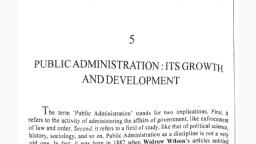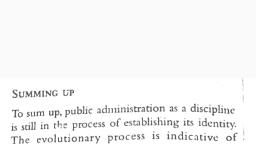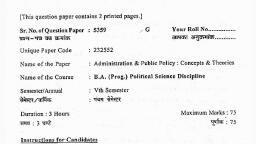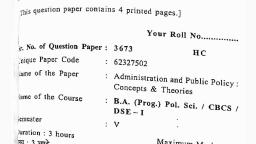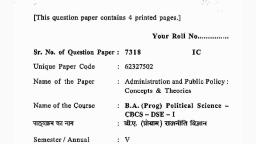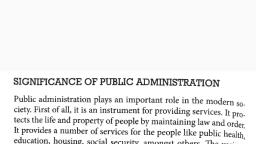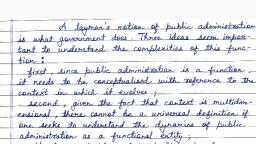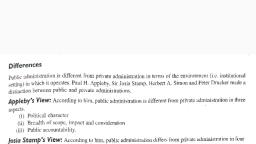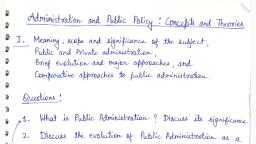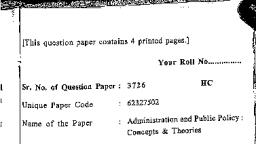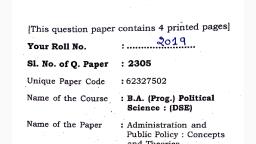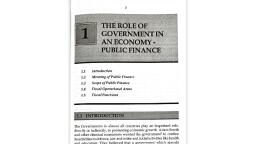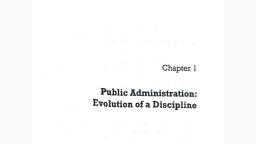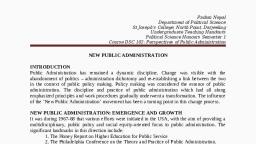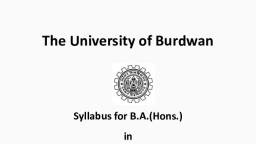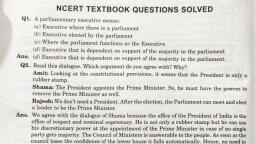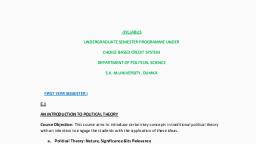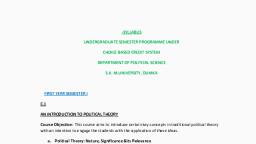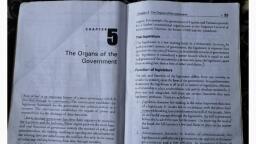Page 1 :
BASIC CONCEPTS OF PUBLIC, ADMINISTRATION, , Public Administration, at least in its embryonic form, was born primarily, and principally to regulate group action and behaviour. When a group of people, started living together and emerged as a community some common problems, made themselves felt which needed collective resolution. One such concern has, been the maintenance of peace and prevention of crime. It was in this category, of needs that for the first time public administration was born. A community, could not have survived if it had not devised a mechanism to regulate and order, its behaviour in certain respects. Regulation of group action was as unescapable, a necessity as was the need for group living. It was only at a much later stage, in the course of its evolution that it found itself engaged in carrying out positive, functions intended to promote human happiness and welfare., , ORIGIN OF PUBLIC ADMINISTRATION, , Public Administration in the beginning was necessarily measly in size, its, functions being absolutely minimal. We do not have figures of the government, employees in India when the crown took over the East India Company in 1858., What we know is that the Government of India employed nearly 11 lakh just, prior to the year 1947, when the country had not become partitioned and divided., The United States of America could perhaps be an apt example., , The total number of federal government employees in the United States was, 126 in the year 1808, nineteen years after the federal government was first created, in 1789. The new government necessarily starts its career with minimum, functions, employing the least number of employees. New activities were taken, up as time passed and new conceptions emerged, necessitating the employment, of newer hands. George Washington, the First President of the United States, of America (1789-97); inducted into the civil service gentleman of good breeding., Such a source of civil service recruitment however could not stabilise into a, well-crystallised convention in years to come. Andrew Jackson, who assumed, the office of Presidency in 1829, held the view that government jobs were easy, and simple and persons of average ability were capable of carrying them out., He also believed in rotation of office so that government job could become
Page 2 :
oe, , 4 Public Administration |, , i qi, , available to almost every citizen. This arrangement of eS a ents, the ‘Spoils System’, which dominated the American pera wed eben m2., The assassination of President James Garfield by a ie a ion ae “J, provoked the U.S. Congress to pass the first civil servic! e hs slace : the, Pendleton, Act, in 1883’ to put an end to the spoils ee eniatai i =, merit as the basis of recruitment. The Civil Service om P in, 1883 to test merit by holding competitive examination. as, , As a result the quality of civil service recruitment considerably improved,, , vs : i il 1854 when Macau,, i ervice recruitment unti ay, In India, patronage ruled the civil s he basis of selection. France had already, , Committee recommended merit as I, er i tury. The Economi, , rter of the nineteenth cent! nomic, adopted merit in the first qua y in thie eceintion ot, , Depression of the 1930’s constitutes another landmar! : t, Anaheal public administration in as much as. it found its role Siisieoratly, enlarged. The concept of the positive state emerged around this time. To counter, the economic depression. Franklin D. Roosevelt s administration (1933-45), initiated bold programmes of economic intervention, collectively known as the, ‘New Deal’. To take up these newer tasks, the recruitment programmes for public, administration were stepped up. The federal bureaucracy as a result expanded, considerably to take up a wholly new array of functions and activities. As the, state was virtually the only large-scale employer in the country because of lack, of employment opportunities in the private sector, the best talent in the society, gravitated into the government. The newly inducted personnel were talented,, motivated and brought distinction to the work they were doing. The image of, the government as a result improved. For the first time, the United States saw, the emergence of the Administrative State., , ORIGIN OF INDIAN ADMINISTRATION, , Developments in India were not wholly dissimilar though the motivations, were different. A sort of mini-Administrative State began taking shape in India, under the logic of the Government of India Act, 1919 even though unconsciously., The act of 1919, implemented in 1921, made a planned beginning towards, responsible government, and introduced dyarchy in the provinces. Under such, an arrangement, department engaged in nation building activities were transferred, tc the elected Indian leaders for self government. This was the first conscious, move of the colonial rulers in India to entrust tasks of governance to people’s, representatives, and the sectors related to agriculture, education. cooperatives,, animal husbandry, irrigation, public health etc. these are the ingredients of whal, later on came to be known as development administration. Both politicians an, (a section of) the bureaucrats received their first planned experience in, developmental activities which stood them in good stead in years to come. This, Aduabeistedtive tae an asset of no small significance to future India. A mini, soiltive stein er ese was emerging. The embryo of what is now calle!, GF iol Ac, (808: te = was born under the dyarchy of the Governmen, embracing, What is reall ~~ of public administration became much mor®, , Bnificance is not the magnitude of the move but the, , fact that all this was taking place unde; ‘, : ; rt i A ; mary, goal lay in maintenance of law and nie Saou. India though Pr
Page 3 :
Basic Concepts of Public Administration 5, , began expanding in all directions in all, public employment. The total number of, and the local governments in the USA was, tral government in India has 4 million public, try, has 7 lakh government, , The functions of government, countries leading to ever-growing, persons employed in the federal, state, over 10 millions in the 1980s. The Cen, functionaries. Great Britain, a much smaller coun, , servants., , Conclusion, , Public Administration is as old as our ancient, independent discipline public administration cannot claim for a long history., Public administration as an academic discipline is barely 127 years old whereas, as an aspect of governmental activity, public administration has been co-existing, with every political system as the action part of government for the fulfilment, of the objectives set by the political decision-makers. From earliest times, administrative system used public administration in executing government, functions. Public administration has gained immense importance since the, emergence of administrative state. Under the impact of science and technology, and the concept of welfare state, the negative concept of the state has been, replaced by the positive concept of the state. Now there is hardly any aspect, of life which does not come under the control or supervision of the state. Its, functions born in the capitalist and the socialist states have become manifold., It is an instrument not only for protection and restraining but also fostering and, promoting. In the words of L. D. White, ‘‘Its nature, contents and scope all, go to make it the heart of problem of modern government.’’! The Public, Administration has come to occupy the great importance in modern society., Administration is essential to maintain peace, harmony and stability in the society., Bhambhri rightly said, ‘‘With the breakdown of the machinery of public, administration, the civilisation shall itself go to pieces. Public administration, stabilises social structure, social organisation and social relationship.’’ All this, clearly reflects that public administration is imperative for all societies developed, or developing, dictatorial or democratic. When public administration is so, important in our daily life its study is worth undertaking., , Gerald Caiden has listed the following crucial roles as assumed by Public, Administration in contemporary society :, , (i) preservation of the polity., , (ii) maintenance of stability and order,, , (iii) institutionalisation of socio-economic change., , (iv) management of large scale commercial services;, , (v) ensuring growth and economic development;, , (vi) protection of the weaker sections of society;, , (vii) formation of public opinion;, , (viii) influencing public policies and political trends., There seems to be an inevitable growing trend in the activities of modern, , public administration. This has resulted in public administration becoming a key, , power in modernising states in its own right., , ee, 1 White L. D. : Introduction to, , civilisation. But as an, , the Study of Public Administration, 1958, p. 16.
Page 4 :
6 Public Administration, A DMINISTRATION, , f public administration, it is necessary to, ng of the term Administration. Administration is a cohieving some common goals. Thus every, , group activity involves administration whether in a family, factory, hospital,, university, OF department. Whenever two men co-operate, , together to do a thing tl have done alone, the rudiments of, , administration appear., The word ‘Administration’ from the English verb administer, ad + ministrare which means ‘to, , which has been derived from the Latin words ‘ i 1, serve’. In simple words it means the management of affairs, or ‘looking after, ‘direct’ or ‘serve.’, , the people.’ To administer is to manage,, 1 field of administration., , Public administration is a part of the wide ‘ n, Administration is a process permeating all collective effort, be it public or private,, , civil or military, large-scale or otherwise. ‘Administration, being 2 characteristic, of all enterprises in pursuit of conscious purposes, is not a peculiarity or speciality, , of modern age ai could weil be perceived quite early, in the growth of civi, , lone. Indeed, its glimmerings, lisation. Building the pyramids was an astonishing administrative, feat. So was the running of the Roman Empire. Public Administration of today,, however, has three, , its functions have enormously i, , Before discussing the meaning 0, , first understand the meani, operating human effort towards ac, , in a government, hat neither could, , is a noun, , distinguishing features - “Its purposes have been completely, ncreased in number, variety and, , reoriented,, complexity, and its methodology has grown from the trial-and-error stage into, d, ever-increasing body of knowledge and, , an orderly discipline with an organize, experience.”!, Administration, thus,, Presthus define Administra, material resources to achiev, Administration, according to John A.Vieg, “is determined action taken in, pursuit of conscious purpose. It is the systematic ordering of affairs and the, calculated use of resources, aimed at making those things happen which we want, to happen and simultaneously preventing developments that fail to square with, our intentions. It is the marshalling of available labour and materials in order to, gain that which is desired at the lowest cost in energy, time and money-”, According to L. D. White, administration is “the direction, coordination, and control of many persons to achieve some purpose or objective.”, Herbert A. Simon points out, “In its broadest sense, administration 64%, be defined as the activities of groups cooperating to accomplish common g04 8, According to E. A. Nigro, “Administration is the organisation and use 0, men and materials to accomplish a purpose.”, , : Thus, it is clear that Administration is collective activi, attainment of a specific goal. It is a rational action to maximize one’s goal by, , _, 1 A Handbook of Public Administration, op. cit, p. 4, k, Ronald Press, p. 3, , d human activities. Pfiffner and, , permeates all organise!, on and direction of human and, , tion as “the organizati, e desired ends.”, , ty directed towards the, rationally, , 2 Pfiffher, John M.. & Presthus, R. Vance, Public i, b R > lic Administration, New Yor 5, 3. Marx, Fritz Morst Ed.), £7 7 q, cen rstein (Ed.), Elements of Public Administration, New Delhi, Prentice-Hall of Indi, 4 Introduction to the Study of Public Administration, op. cit., p. 2, ” York, 1950, B®, , simon, Smithburg & Thompson, Public Administration, New York, Alfred A Knopf,
Page 5 :
a, , Basic Concepts of Public Administration 7, , means. But every collective activity cannot be called administration. In fact two, features—organisation and management are special features of administrative activity., , So we can say that administration is only that type of collective activity which involves, rational organisation and management of men and material., , PUBLIC ADMINISTRATION, , As stressed at the outset, Public Administration is a segment of the wider, field of ‘administration’. But on its meaning, there are differences. According, to some, the use of the word ‘Public’? before ‘Administration’ restricts its, Coverage to the administrative activities of the government—government being, the only organization which covers within itself all the people living in the state., According to them, Public Administration is defined as the organization and, management of human and material resources to fulfil the objectives laid down, by the government. But government, as we all know, consists of three, branches—legislature, executive, and judiciary. Is Public Administration to study, all these three branches that make up the government ? Views on this question, are also divided. To some, Public Administration is identified with the entire range, of government activities covered under the three branches : whereas others, restrict it (.e., Public Administration) to the operations of the executive branch, only. It may be appropriate here to quote W.F. Willoughby : “The term, ‘administration’ may be employed in political science in two senses. In its, broadest sense, it denotes the work involved with actual conduct of governmental, affairs. It is, thus, quite proper to speak of the administration of legislative branch, of government, the administration of justice or judicial affairs, or the administration, of the executive power as well as the administration of affairs of the, administrative branch of government, or the conduct of the affairs of the, , government generally. In its narrowest sense, it denotes the operations of the, administrative branch only.”!, , L. D. White defines Public Administration in the broader terms. According, to him, Public Administration “consists of all those operations having for their, purpose the fulfilment or enforcement of public policy.”?, , Luther Gulick, on the other hand, views Public Administration as, embracing the executive branch of government only. “Public Administration,” he, writes, “is that part of the science of administration which has to do with, government and, thus, concerns itself primarily with the executive branch, where, the work of government is done, though there are obviously aipinieuetee, problems also .in connection with the legislative and judicial branches., , i “Publi inistrati ists of doing the, ding to John M. Pfiffner, “Public Administration consis, work @ eeumeick whether it be running X-ray machine in a health laboratory or, , ; int24, coming money in the mint.”, , | wioughby. W. F.. Principles of Public Administration, Indian Edition, Allahabad, Central Book, 1 illoughby, W. F., , Depot, p. }., , # ys Be ", : pa = 2 male Values and Public Administration, in Luther Gulick & L. Urwick (Eds.),, 3 Gulick, Luther,, , e Qj inistration, New York, Institute of Public Administration, 1937, p., the Scienc Adm 1. f Pub!, Papers on the af, , 191., , 4 Pfiffner, John M Public Administration, New York, 1946, p. 6., 1 T, *



